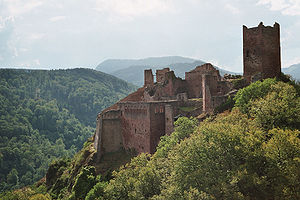- Château de Saint-Ulrich
-
The Château de Saint-Ulrich (also known as the Château de Grand-Ribeaupierre) is one of three castles (with the Girsberg and the Haut-Ribeaupierre) which dominates the commune of Ribeauvillé in the Haut-Rhin département of France. It is situated at an altitude of 528 m.
The present name of the site is from the chapel dedicated to Saint Ulrich of Augsburg which is found in the castle. Medieval texts never gave the present name - the castle had the name of the Rappolstein dynasty (or Ribeaupierre in the French style).
From the 11th to the 16th centuries, the castle was the principal residence of the powerful lords of Ribeaupierre. There must have been another castle on the same site which belonged in 1114 to the Bishop of Basle. It was occupied militarily by Henry V, Holy Roman Emperor, who used it as a strongpoint in his war against the Eguisheims. It was then returned tpo the Bishop of Basle who restored it to the Ribeaupierres. Anselme II de Ribeaupierre, who chased the other members of the family from the castle, successfully survived two sieges, in 1287 by Rudolph I of Germany and, in 1293, his successor Adolf. A celebrated crimal, Dame Cunégonde d'Hungersheim, was incarcerated in the keep and tried to escape with the aide of a guard.
The castle is a very fine example of the military architecture of Alsace in the Middle Ages, including a keep erected in the 12th century and a residence with chimney, also 12th century. In the 13th century, the salle des chevaliers (knights' hall) was decorated with nine beautiful windows in the Romanesque style which can still be seen. In the same period (1435), the chapel dedicated to Saint Ulrich, Bishop of Augsburg, was built.
The Ribeaupierre family left this castle in the 16th century for a Renaissance-style mansion (the present school in Ribeauvillé). The castle was dismantled during the Thirty Years' War.
Contents
The castle today
The visible remains date from several epochs:
- 12th century : Square keep and the corps de logis
- 13th century : Salle des chevaliers, and the residential tower
- 14th century : Barbican and outer enceinte
- 15th century: Chapel (Saint-Ulrich)
The Château de Saint-Ulrich has been listed since 1841 as a monument historique by the French Ministry of Culture.The legend of the mortal arrow
Two Ribeaupierre brothers, one living in the château de Saint-Ulrich, the other in Girsberg, had agreed to go hunting the next day. They had arranged a signal: the first to wake would fire an arrow at the other's shutters. The Saint-Ulrich brother awoke first and shot an arrow towards his brother's shutters. But the latter, at the moment the arrow arrived, opened his shutters. He died, his heart pierced.
Bibliography
- Braun, Jean, Circuit des châteaux forts d'Alsace - Ingersheim : éd. SAEP, 1978 - collection Delta 2000.
- Carmona Christophe & Trendel, Guy, Les Châteaux autour de Ribeauvillé et Ricquewihr - Sarreguemines, éd. Pierron, 2001 - collection Les Châteaux des Vosges : histoire, architecture, légendes n°7.
- Mengus, Nicolas, Au temps des châteaux forts en Alsace - Strasbourg, éd. Coprur, 2004.
- Salch, Charles-Laurent, Nouveau dictionnaire des châteaux Forts d'Alsace, Alsatia, 1991.
See also
External links
- Ministry of culture listing (French)
- Ministry of Culture photos
- Description of castle on the CRDP Alsace website (French)
- Description of castle on the Alsa'VTT website (French)
- Description of castle on the L'Internaute website (French)
References
- This article incorporates information from this version of the equivalent article on the French Wikipedia.
Coordinates: 48°12′10″N 7°18′19″E / 48.20278°N 7.30528°E

This castle-related article is a stub. You can help Wikipedia by expanding it.









